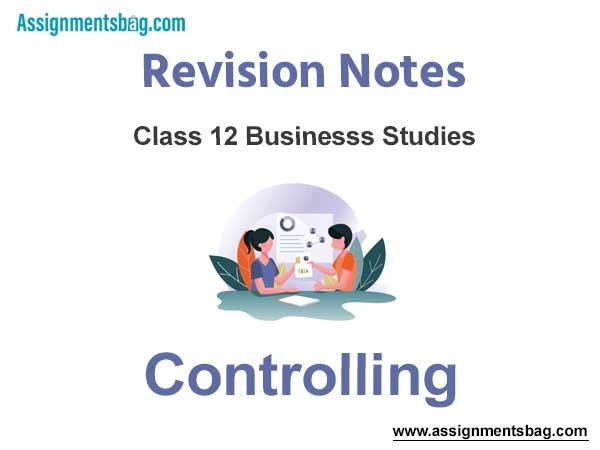Please refer to the Controlling Revision Notes given below. These revision notes have been designed as per the latest NCERT, CBSE and KVS books issued for the current academic year. Students will be able to understand the entire chapter in your class 12th Business Studies book. We have provided chapter wise Notes for Class 12 Business Studies as per the latest examination pattern.
Revision Notes Chapter 8 Controlling
Students of Class 12 Business Studies will be able to revise the entire chapter and also learn all important concepts based on the topic wise notes given below. Our best teachers for Grade 12 have prepared these to help you get better marks in upcoming examinations. These revision notes cover all important topics given in this chapter.
CONCEPT and DEFINITION :
Controlling function can be defined as comparison of actual performance with the planned performance. If there is any difference or deviation then finding the reasons for such difference and taking corrective measures or action to stop those reasons so that in future there is match between actual and planned performance.
Managerial Control implies the measurement of accomplishment against the standard and the correction of deviations to assure attainment of objectives according to plans.
Koontz and O’ Donnel
IMPORTANCE OF CONTROLLING :
1. Accomplishing organisational goals: Controlling function ensures that all the activities in the organisation take place according to plan and if there is any deviation, timely action is taken and keeps them on the right track so that organisational goals might be achieved.
2. Judging accuracy of standards: Through strategic controlling, we can easily judge whether the standards or target set are accurate or not. An efficient control system keeps a careful check on the changes taking place in the organisation and in the environment and helps to review and revise the standards according to changes.
3. Making effective use of resources: In controlling, each activity is performed in accordance with predetermined norms. It acts like a traffic signal and guides the organisation and keeps it on the right track. As a result, wastage and spoilage of resources will be reduced so that effective and efficient use of resources can be ensured.
4. Improving employee motivation: A good control system ensures that employees know well in advance what they are expected to do as well as the basis against which their performance will be appraised. Thus, it motivates them to give better performance.
5. Ensuring order and discipline: Control creates an atmosphere or order and discipline in organisation. It keeps the employees under check and helps to minimize dishonest and fraud behaviour of employees. Now-a-days, computer monitoring system is contributing a lot to the controlling function.
6. Facilitates coordination in action: The activities of each department and employee are governed and controlled by pre-determined standards which are well coordinated with one another. So, control provides unity of direction.
CONTROLLING PROCESS :
Controlling is a systematic process involving the following steps:
1. Setting performance standards
2. Measurement of actual performance
3. Comparison of actual performance with standards
4. Analyzing deviations
5. Taking corrective action.
The above steps in the process of controlling have been discussed below:
1. Setting performance standards: Standard means the yardstick against which actual performance is measured. Following points to kept in mind before setting the standard.
1. As far as possible standards must be set up in numerical or measurable term, i.e. Standard sale – Rs.20 lakhs, Standard Profit – Rs.4 lakhs, Reduction in cost by 5%.
2. Sometimes standards may also be set in qualitative terms, i.e. improving goodwill and motivation level of employees.
3. Standard must be set up keeping in mind the resources of the organisation and must be achievable
4. Standards should be flexible enough to be modified due to changes taking place in internal and external environment
2. Measurement of actual performance: In second step, the actual performance should be measured through personal observation, sample checking, performance reports, calculation of ratios, etc. The measurement should be objective and reliable. Further, while measuring performance, the quantitative and qualitative aspect should be kept in mind. Performance must be measured periodically in short period of time.
3. Comparing actual performance with standard: Comparison becomes easier when the standards are set in quantitative terms. The comparison of actual with the standard will reveal the deviation if any. If there is match in both, then the controlling function ends there only. But, if there is mismatch, then the manager tries to find out the extent of deviation. If the deviation is minor, it should be ignored. But, if the deviation more, then timely action must be taken.
4. Analyzing deviation: Deviation should be divided in two categories as
1. Deviations need to be attended urgently.
2. Minor or insignificant deviations
Below mentioned two ways are to be applied during the analyzing of deviations.
(a) Critical point control: It means keeping focus on some Key Result Areas (KRAs) which are critical to the success of an organisation. If anything goes wrong in these critical points, then it must be attended urgently.
(b) Management by exception: It means a manager who tries to control everything may end up controlling nothing. Thus, only significant deviations which go beyond permissible limit should be brought to the management. Managers should not waste time and energy in finding solutions for minor deviations.
5. Taking corrective action: The final step in controlling function is to find out the reasons for deviations which need immediate attention and trying to remove deviation in future. Taking corrective measures may involve training of employees, assigning of additional workers and equipment, change in the quality of materials, repair or replace the machinery, improving physical conditions of work.




